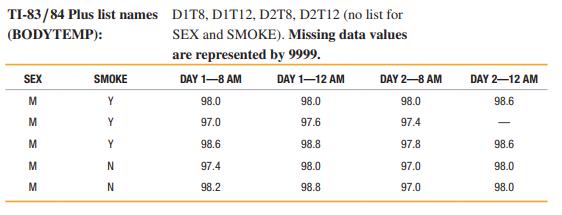In the sign test procedure described in this section, we exclude ties (represented by 0 instead of
Question:
In the sign test procedure described in this section, we exclude ties (represented by 0 instead of a sign of + or -). A second approach is to treat half of the 0s as positive signs and half as negative signs. (If the number of 0s is odd, exclude one so that they can be divided equally.) With a third approach, in two-tailed tests make half of the 0s positive and half negative; in one-tailed tests make all 0s either positive or negative, whichever supports the null hypothesis. Repeat Example 4 “Body Temperatures” using the second and third approaches to handling ties. Do the different approaches lead to very different test statistics, P-values, and conclusions?
Example 4:
Data Set 3 “Body Temperatures” in Appendix B includes measured body temperatures of adults. Use the 106 temperatures listed for 12 AM on Day 2 with the sign test to test the claim that the median is less than 98.6°F. Of the 106 subjects, 68 had temperatures below 98.6°F, 23 had temperatures above 98.6°F, and 15 had temperatures equal to 98.6°F.
Data Set 3: Body Temperatures
Body temperatures (oF) are from 107 subjects taken on two consecutive days at 8 AM and 12 AM (first five rows shown here). SEX is gender of subject, and SMOKE indicates if subject smokes (Y) or does not smoke (N). Data provided by Dr. Steven Wasserman, Dr. Philip Mackowiak, and Dr. Myron Levine of the University of Maryland.

Step by Step Answer:

Mathematical Interest Theory
ISBN: 9781470465681
3rd Edition
Authors: Leslie Jane, James Daniel, Federer Vaaler





